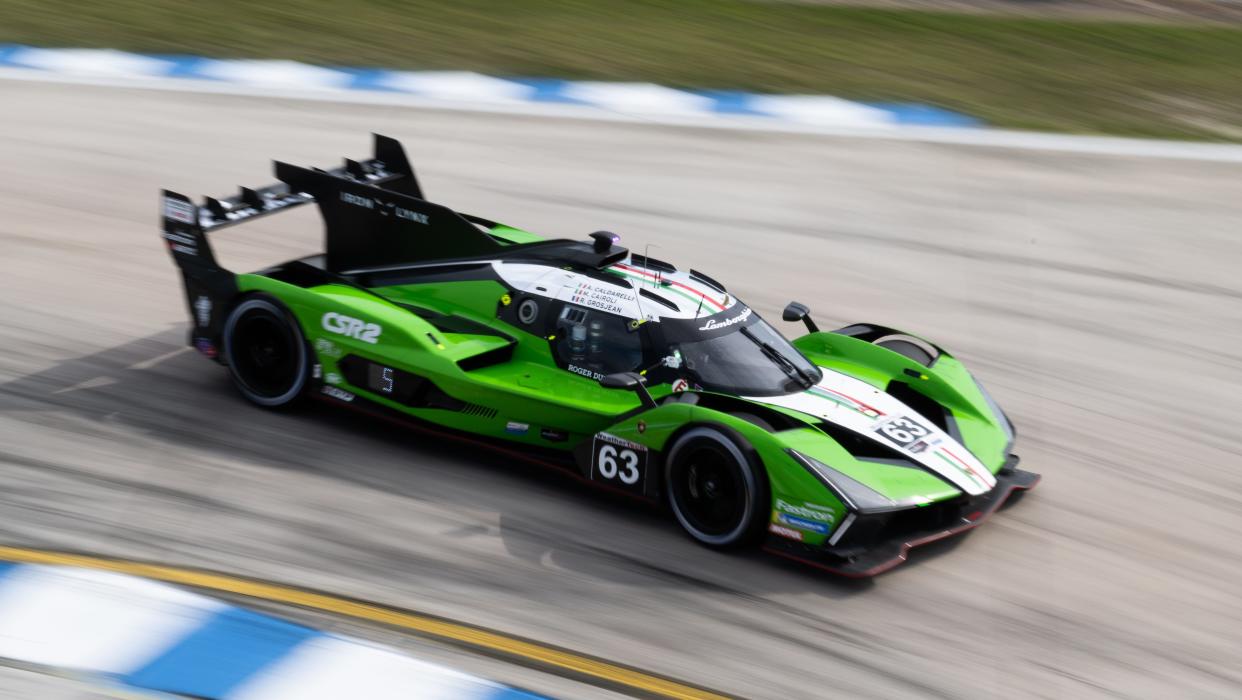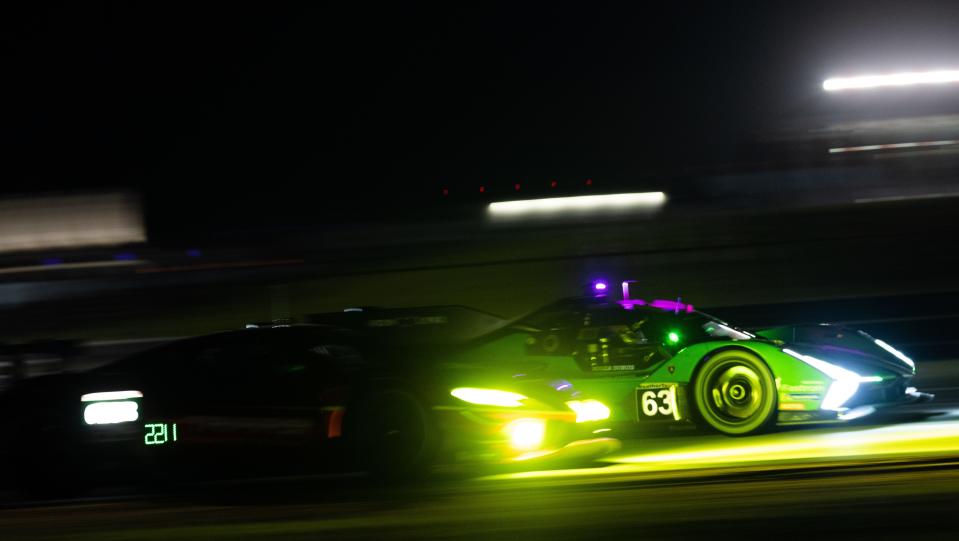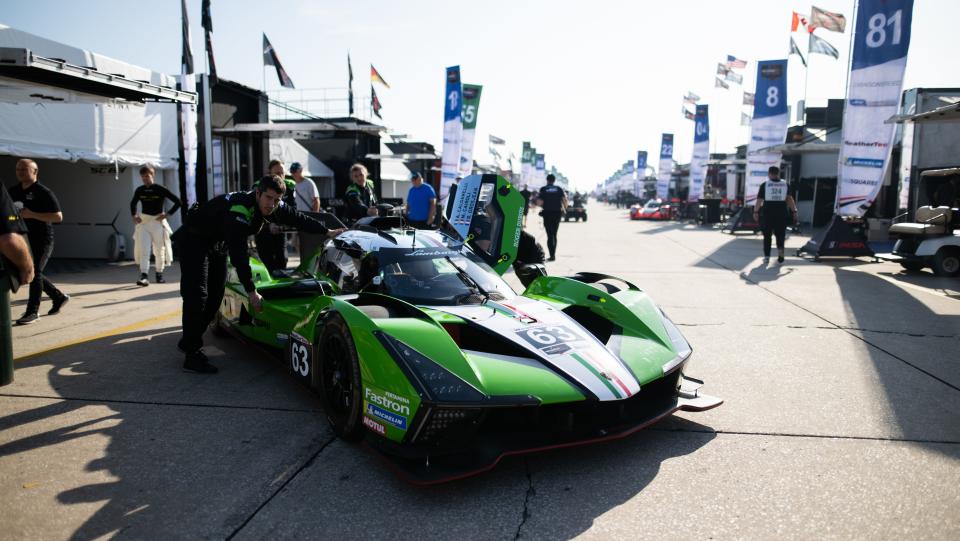Lamborghini Just Debuted Its Newest Hypercar at Sebring

Lamborghini’s new SC63 prototype racecar made its American debut at the 12 Hours of Sebring this past weekend, joining Porsche, Cadillac, BMW, Alpine, and Acura in the new LMDh class introduced last year. As the acronym suggest, the LMDh class combines the regulations for Le Mans and Daytona hybrid racecars to allow manufacturers to compete at the highest level of global endurance racing.
The SC63 previously raced at Lusail Circuit, in Qatar, but arrived at Sebring after an accelerated timeline since the development of the clean-sheet car began in 2022. Despite a late start compared to other teams in the series, most of which kicked off the new era at the Rolex 24 Hours of Daytona in January of 2023, Lamborghini plans to continue competing with the Iron Lynx Racing Team for the rest of the 2024 season before adding at least one more car to the fleet for 2025.
More from Robb Report
Meet the New 1,300 HP Electric Supercar That's Gunning for Ferrari and Lamborghini
A Rare 1976 Lamborghini Countach Could Fetch $1.4 Million at Auction
“When the LMDh concept came up, it was tempting for us,” Lamborghini CEO Stephan Winkelmann told Robb Report at Sebring. “We are in the midst of the transition from ICE engines to hybrid cars… This is one reason it perfectly fits to do LMDh, for testing ideas. It’s important for us, we have to have a learning curve.”
Every LMDh team uses the same battery-electric hybrid system provided by Bosch but can then employ their own internal-combustion engine and unique aerodynamic packages on top of the choice between four chassis options built by Dallara, Ligier, Multimatic, or Oreca. Where Porsche decided to partner with Multimatic and adapted a twin-turbocharged V8 that first appeared on the 918 Spyder supercar, for example, Lamborghini made the surprising choice to go with a chassis from Ligier—the only company so far to do so.

The SC63 also employs an entirely new twin-turbocharged 3.8-liter V8 that shares zero components or specifications with any previous Lambo engine, including the 4.0-liter V8 in the Urus SUV. But LMDh’s regulations, as measured by sensors in the car’s drive axles, make the 671-hp powerplant’s engineering focus less on peak output and more on reliability.
Due to the SC63’s relatively brief development period—which included a crash in August of 2023 that sidelined the car for approximately one month—Lamborghini arrived at Sebring harboring minimal hopes of taking home a class win. Sebring itself presents an especially unique challenge, as well, because of the track’s bumpy, crackling surface. As the only team currently fielding one vehicle, which reduces the amount of testing data acquired during Sebring’s three free practice sessions, drivers Romain Grosjean, Matteo Cairoli, and Andrea Caldarelli nonetheless needed to help dial in suspension and tire setups to absorb as much of the uneven tarmac as possible.
And yet, only a few hours into the race, Chief Technical Officer Rouven Mohr noted that the SC63 had managed to log a fastest-lap time only about a second slower than the leading Cadillac. Unfortunately, though, the car’s tires seemed to be struggling to warm up—meaning that after any pit stop or safety car, the team would lose around 20 seconds before being able to hold a steady pace. He attributed the trend to the interplay between suspension damping and downforce while keeping the SC63 as low as possible to maximize the aero package, but without riding so stiff that bounces might lift a driven wheel up off the ground and result in too much torque reaching the axle sensors, which could cause a penalty.
Mohr also communicated with Ligier’s team throughout the leadup and race at Sebring, hoping to collect data from different setups that might help in future competition. But the other teams, running two or three cars each, can experiment with more setup variables and collect far more information to inform their own efforts.
“The strength of Lambo is that we are a very small team,” Mohr said, “But we need mileage, mileage, mileage, collecting data, and also for specific tracks. But the others are also refining their performance… This is motorsport, this is what we want. We want the competition.”

As the sun set over central Florida, a couple of dramatic crashes and mechanical failures on other teams’ cars helped the SC63 climb up steadily in the LMDh ranking, from the first seven or so hours spent steadily in last place. And by the time flashing lights streaked by in full darkness, the delta between Lambo’s fastest lap and the now-leading Acura’s dropped to only 0.4 seconds—which Mohr views as an incredible feat for the team, and inspiration to keep working hard to improve the SC63’s potential.
Similar to the GT3-class Huracans, Mohr views the LMDh project as a way to continue developing Lamborghini’s overall competency. As an example, he pointed out that working on the SC63 provided a surprising education on how to reduce friction between individual suspension system components. And vice-versa, he believes Lamborghini’s forthcoming hybrid road cars, the 1,000-horsepower Revuelto and hybrid Urus, also helped make the LMDh racer easier for the Iron Lynx drivers to modulate given the interaction between the V8 and Bosch’s electric modules.
The SC63 eventually climbed to seventh place in class at Sebring and finished the race on the same lap as the winning Acura. That’s a big step up from the first race of the season at Qatar, where the car wound up five laps off the lead in 15th place. Lamborghini will aim to continue building on the improvement as the 2024 World Endurance Championship moves on to Imola in April and then at IMSA’s Watkins Glen race later in the summer. In a strong field, it seems racing on Sunday (or in this case, Saturday) to sell on Monday will remain a critical portion of Lambo’s ethos moving forward.
Best of Robb Report
Sign up for Robb Report's Newsletter. For the latest news, follow us on Facebook, Twitter, and Instagram.

